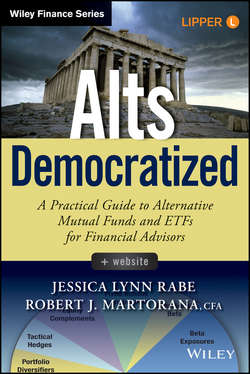Читать книгу Alts Democratized - Rabe Jessica Lynn - Страница 11
На сайте Литреса книга снята с продажи.
Chapter 1
Definitions and Methodology
The Future
ОглавлениеThere is currently no industry standard for exactly what constitutes an “alternative” investment. The definition of liquid alts is continually evolving, and precise classifications are in the eye of the investor.
The future of liquid alts is likely to include some form of private equity, such as leveraged buyouts, mezzanine financing, infrastructure, and venture capital. These are now difficult to package effectively in a '40 Act structure, but strong investor demand suggests that this is a large potential market for product providers that can innovate.
The definition of liquid alts may also expand to include forms of so-called smart beta. Smart beta uses rules-based approaches to define factor exposures, such as indexes that are not weighted by market capitalization, but by equal weights or fundamental factors such as sales, profits, or price-to-book ratios. Smart beta also includes sophisticated algorithms for optimization, such as minimum variance, maximum diversification, and risk-efficient indexes.
The factor exposures discussed in this book may overlap with some forms of smart beta. Chapter 7 discusses Alternative Equity Market Neutral Funds, and includes the PIMCO Fundamental Advantage Absolute Return Strategy Fund (PFATX). This fund has long exposure to a smart beta strategy, a fundamental equity index called the Enhanced Research Affiliates Fundamental Index (Enhanced RAFI 1000). PFATX also has a short exposure to the Standard & Poor's (S&P) 500 index, so the fund seeks to capture the return premium of an index that is weighted according to fundamentals over an index that is weighted according to market capitalization. This is an example where liquid alts and smart beta converge, and there is room for disagreement as to the demarcation between smart beta and liquid alternatives.
Note: This book focuses on the track record of funds through year-end 2013. We occasionally note subsequent events, such as the departure of Bill Gross from PIMCO (see PFIUX in Chapter 9), and the downturn in returns at MainStay Marketfield (see MFLDX in Chapter 10). These events highlight the need for ongoing due diligence of liquid alternatives, especially for funds that give broad discretion to the portfolio manager.
This book focuses on funds that Lipper classifies as alternative, and the underlying factor exposures of these funds. This provides a clear, functional, and comprehensive map of the liquid alts space. These classifications will continue to evolve, and may eventually include smart beta and private equity. The authors believe that the Lipper data provide a useful framework and functional tools for asset allocation and fund selection, and the Lipper classification methodology is among the most practical and accurate systems that are widely available at this point in time.
